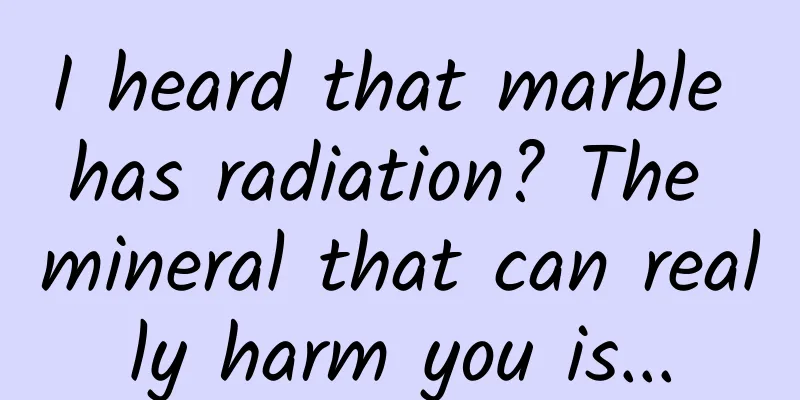I heard that marble has radiation? The mineral that can really harm you is...

|
"Marble has radiation, it is dangerous to keep it at home", "Fluorescent stones have stronger radiation", "Radiation can cause gene mutations" Are these statements true? The 16th issue of the **** science popularization public welfare series short video "Reliable" launched by the Zhejiang Science Popularization Federation will reveal the secrets of glowing stones! Scientific principles revealed In this issue of "Reliable", Shi Zhanle, a gold medal science expert from Zhejiang Geological Museum, answers our questions! There are many types of radiation. The radiation mentioned in this issue of "Reliable" refers to "ionizing radiation"~ Does everything have radiation? Teacher Shi said: "All matter, as long as it is not at absolute zero, has radiation." Absolute zero is -273.15℃. If a substance reaches absolute zero, the thermal motion of particles inside it will stop, so there will be no thermal radiation. Absolute zero is a temperature standard proposed by physicists, and there is no temperature lower than this. In fact, it is impossible for any substance to reach absolute zero! So, "everything has radiation". From the universe to the earth's surface, and even in people's bodies, there is radiation. These are natural background radiation, and its instantaneous dose is about 0.15~0.2 microsievert per hour. Teacher Shi continued, “So we often say that talking about radiation without considering the dose is a hooligan behavior .” How much do you know about radiation? Next, Mr. Shi used a Geiger counter to test various minerals to see if they had any radiation! △ Apatite For humans, the safe range of radiation should be an instantaneous dose of around 0.2 microsieverts per hour. Taking apatite as an example, its dose is 4.47 microsieverts per hour, and the safe distance of radiation is about 15 centimeters. If the distance from it is half a meter, it is not easily affected by radiation. Fluorescence = radiation? The ore in the picture emits fluorescence. The green one is willemite, the red one is calcite, and the black area is ferrospinite and rutile. Will it have a high radiation? In fact, its radiation dose is only 0.13 microsieverts per hour, which is within the safety standard. So, fluorescence does not mean high radiation ! What harm does radiation do to the human body? If a large amount of radiation (such as a nuclear explosion) is generated in a short period of time and irradiates the human body, it may damage the human cell structure (such as DNA) at the microscopic level, and in severe cases, it may cause massive internal bleeding and organ failure. If a fertilized egg or embryo is exposed to radiation, it may cause genetic mutations. In fact, even an ordinary table will have radiation. The marble slabs available on the market, as long as they come from legitimate channels, have been tested for radioactivity and can be used with confidence. In addition to this, what other scientific principles are there? Welcome to continue to follow "Reliable"! |
Recommend
Samsung Note Edge curved screen experience is very easy to operate after getting used to it
Although Samsung had a difficult year in 2014 , t...
Three key words for Internet business: product, traffic, and conversion rate
Traffic operation cannot be carried out blindly w...
Why do I want to cry when I have a quarrel? I feel so much empathy...
Editor: Dong Xiaoxian...
Xiaohongshu promotion skills and operation strategies!
I have to say that the speed of development of th...
Which company providing SEO optimization services in Jiayuguan is better? How to choose?
Nowadays, due to the increasing bidding costs, ma...
The correct approach to enterprise short video operation
First of all, for enterprises, it is obviously no...
Mother's Day copywriting is here, here is a secret to seduce your mom!
This Sunday, May 13th is Mother's Day . In ad...
How much does it cost to develop a Baotou fast food mini program?
How much is the quotation for Baotou fast food de...
I didn’t know that “air conditioning water” had so many wonderful uses…
1. Irrigation of household plants The condensed w...
What exactly is going on with renting a boyfriend or girlfriend during the 2020 Spring Festival? How much?
The 2020 Spring Festival is approaching, and many...
32-bit is dead. What does this mean for Android and Apple?
[[405514]] This article is reproduced from Leipho...
A practical guide to KOL marketing丨Winning strategies for brand marketing on Xiaohongshu
As media becomes increasingly fragmented and dive...
Is the tap water at home getting hotter and saltier? Be careful that it may be the heating water "visiting"! Reminder →
During the winter heating period, heating water o...
The reshuffle of shared power banks has begun, but it is unlikely to become the next shared bicycle
The rise of the sharing economy has brought in a ...
14 professional operation tools that are essential for Internet operators!
As an Internet operation practitioner, if you wan...









